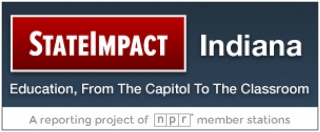In preliminary numbers compiled by State Board of Education staff, 17 percent of Indiana’s K-12 schools will be considered failing under the state’s A-F accountability system. Last year, 4 percent of schools were considered failing.
StateImpact obtained the summary sent to State Board of Education members, but these data haven’t been made public.
A-F grades are largely calculated with ISTEP+ scores earned by third through eighth graders. So elementary and middle schools represent the majority of the failing schools.
This year’s ISTEP+ was new to teachers and students because it was the first assessment under Indiana’s new academic standards.
The summary of grades shows that not only could 17 percent of schools receive an F, but almost 19 percent will get a D, that puts more than a third of schools in the lowest performing categories.


The statistics are troubling but not unexpected.
In some ways the writing was on the wall. Other states that adopted new standards saw a dip in scores the first year a new assessment was used.
For example, North Carolina saw its number of passing students drop by almost half.
In the 2012-2013 school year, before the new assessment was implemented, almost 60 percent of students were considered proficient. The next school year, after they took a new test, 32 percent of students were proficient.
Seeing the experiences of other states led state superintendent Glenda Ritz to advocate for a change in the A-F system to avoid putting more schools in the failing category.
The idea had precedent. For example, after the first year students in Ohio took an assessment aligned to new standards, the state redefined its ‘proficiency’ level, by lowering the score it required to meet the passing standard. South Carolina and California chose to use an option set forth by the U.S. Department of Education, that allows states to skip a year in accountability while students adjust to the new assessment.
Indiana is one of the states that can take USED’s offer to pause accountability for schools without consequences, but in a letter to Secretary Arne Duncan sent in June 2014, Gov. Mike Pence wrote:
“Our administration is firmly committed to maintaining student assessment and teacher and school accountability without interruption. Testing gives us an accurate picture of how our students are doing and what help they need in the classroom. Indiana will not go backwards when it comes to measuring performance in our schools on my watch.”
He later changed his tune slightly and in October he sent a letter to the state board asking it to look at options where low test scores wouldn’t impact teacher bonuses or evaluations. He did not ask for relief regarding the grades schools would receive.
Ritz meanwhile continued to stress that scores in Indiana would drop and it could be significant. She publicly urged lawmakers and state board members to consider adjusting the accountability system to avoid punishing a lot of schools. At a special meeting Feb. 13, amid panic about the length of this year’s ISTEP+, she and the IDOE proposed a resolution asking the board to approve a freeze in accountability.
But the board didn’t vote on the resolution, with everyone but Ritz unanimously removing it from the agenda and tabling the conversation.
At the July 1 meeting, Ritz and the IDOE brought new options to the board. Rather than freezing accountability and allowing a school to carry its A-F score from the 2013-2014 school year through the 2014-2015 one, they presented twelve options to alter accountability. IDOE preferred the “hold harmless” approach. In this plan, the state would issue grades as normal but give schools the better grade between the two years.
Board member Gordon Hendry, a staunch opponent to Ritz’s suggestions on changing accountability, responded with this:
“I feel like you can have your cake and eat it too,” Hendry said. “You get all of the upside and none of the downside. That doesn’t really seem to be a fair way to approach it. The logic just doesn’t seem to make sense there.”
The rationale was hold off on the discussion –or a decision- until scores were available.
SBOE spokesperson Marc Lotter says the board will not comment on embargoed, preliminary data, but the board does not have power to change the A-F system if it wanted.
“As was noted in the Attorney General opinion earlier this year, the ability to adjust that model falls outside of the board’s ability. So it’s something that would fall to the General Assembly and the governor.”
And Department of Education and Ritz’s spokesperson Samantha Hart says the superintendent’s view on adjusting accountability hasn’t changed.
“Superintendent Ritz believes ISTEP+ results are not a fair representation of the great teaching and learning that happens in our schools every day, but a result of changing academic standards and a more rigorous ISTEP+,” Hart says. “However, the Attorney General has said that Superintendent Ritz cannot do this on her own. Unfortunately, Governor Pence has so far refused to give schools much needed flexibility. Moving forward, Superintendent Ritz will be working with legislative leadership to ensure that our local schools and children get the support and flexibility they need.”
A call to Governor Pence’s office was not returned, Senate President Pro Tem David Long declined to comment and House Speaker Brian Bosma was unavailable for comment.
But now that is data it out there, and so many schools would be considered poor performing, the discussion is likely to reignite.
How Will Legislative Leaders Address the Low Scores?
The legislature addressed it briefly on Organization Day last month, the unofficial start of the legislative session, when House Speaker Brian Bosma, R-Indianapolis, said one of the first things the General Assembly will address in January is how A-F scores will affect teacher bonuses.
“We’re going to expedite a bill that will decouple the teacher performance pay from the school grades for a year.”
And when asked if the legislature would consider doing the same thing for schools, he said it’s not off the table, but doesn’t see how it would be necessary.
“Personally I don’t think how a teacher’s performance or a school’s performance would generally alter dramatically from year to year. I’m sure there are cases where it could but it wouldn’t be the rule.”
Having this many schools carrying a D or F grade poses a real problem for both the schools and the state. In the first year a school receives an F, the state requires the school to issue a public notice of its grade, hold a public hearing where community members can testify on school improvement.
The IDOE’s turnaround committee also has influence over a school’s use of resources including finances and personnel. It can so ask the SBOE to appoint an outside group to help a school make changes to improve its grade.
The federal government requires similar actions, but also makes failing schools prove the principal and teachers are capable of making improvements.
Schools receiving a D must generate reports for the federal government identifying the root cause of why they are performing poorly and lay out an improvement plan.
At the SBOE meeting Wednesday, the board said it has released the preliminary grades to schools. Each school has time to review and appeal the data so it’s possible the letter grades could change before they’re publicly released next month.
 DONATE
DONATE








 View More Articles
View More Articles




 Support WFYI. We can't do it without you.
Support WFYI. We can't do it without you.